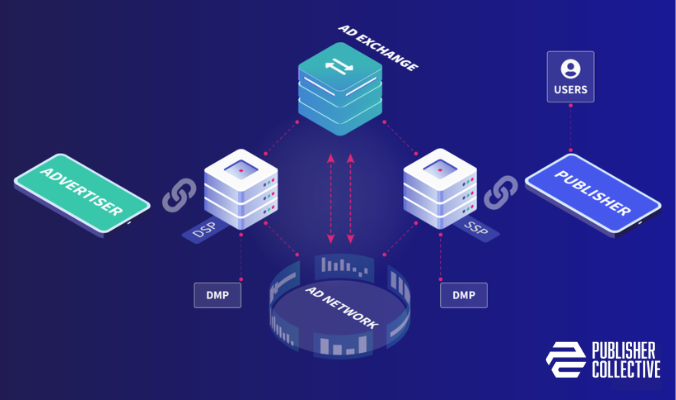Introduction to Programmatic Advertising

If you’ve been in the publishing game for a while, you’ve probably heard the term “programmatic advertising” more times than you can count. But if you’re still a little foggy on the details, or just want a better understanding of how it really works and what it can do for your business, then you’ve come to the right place.
This guide offers a clear, beginner friendly introduction to programmatic advertising: how it works, why it matters, and what it means for publishers like you.
Want to go even deeper? Check out our comprehensive e-book, where we break down the entire programmatic ecosystem and include a handy glossary to help you decode all those acronyms.
What is Programmatic Advertising?
Programmatic advertising is the automated buying and selling of digital ad space. Instead of negotiating with advertisers directly or working with sales reps to fill inventory, programmatic technology does the heavy lifting for you, using algorithms and data to serve the right ads to the right users at the right time.
Programmatic advertising brings together buyers and sellers through an ad exchange, a digital marketplace where advertisers look to purchase online ad space, and digital publishers offer their available inventory for sale.
Think of it like this: programmatic is to digital advertising what autopilot is to flying. It streamlines the process, makes it more efficient, and allows you to focus on what you do best: creating quality content and growing your audience.
Key Players in Programmatic Advertising
Programmatic advertising relies on a mix of tech platforms that automate the buying and selling of ads in real-time. The key players in the ecosystem include:
Ad Servers
Think of these as the traffic controllers of your ad operations. They manage your ad inventory, apply targeting and delivery rules, and ultimately decide which ad gets shown to each user. They’re essential for keeping everything organized and running smoothly. Google Ad Manager is probably the most well known Ad Server.
Supply-Side Platforms (SSPs)
SSPs help publishers monetize their ad space. They connect your inventory to multiple demand sources, run auctions in real-time, and help you maximize the value of each impression by inviting bids from various advertisers. Some popular SSPs include OpenX, Magnite, and Index Exchange.
Ad Exchanges
These are the digital marketplaces where the buying and selling actually happen. When an impression becomes available, it’s listed on an exchange, kind of like putting it up for auction. Advertisers then have the chance to bid on it in real time. Many ad exchanges are built into SSPs.
Demand-Side Platforms (DSPs)
Advertisers use DSPs to find and bid on available impressions across the web. These platforms use tons of data, like user behavior, interests, location, device type, and more, to decide which impressions are most valuable and worth bidding on.
How Does Programmatic Advertising Work?
At the core of this system is your ad inventory. When a user lands on your website, a series of automated steps unfolds in milliseconds to determine which ad will appear. Here’s a simplified flow of how it typically works:
- A user visits your site.
- Your ad server detects an available impression and applies your targeting and delivery rules.
- The SSP is alerted and makes the impression available to potential buyers.
- The impression enters an ad exchange where real-time bidding (RTB) takes place.
- DSPs used by advertisers assess the impression using various data points (user behavior, location, device, etc.).
- Advertisers submit bids, and the highest bid wins.
- The winning ad is served, usually in under 100 milliseconds.
The system is dynamic, data-driven, and heavily reliant on automation. So, you’re not just filling ad space, you’re monetizing it in the smartest, most effective way possible.
Most publishers don’t rely on just one ad exchange. Instead, they use a mix to tap into multiple demand sources and drive up competition for their ad space. The best way to do this is through header bidding.
What is Header Bidding?
Header bidding allows you to connect to multiple ad exchanges simultaneously, increasing competition for your inventory and driving higher CPMs (cost-per-mille). However, it can be complex to manage if you don’t have a team of developers and AdOps specialists.
That’s why many publishers choose to work with a header bidding partner like Publisher Collective. These partners handle the implementation, optimization, and ongoing management of header bidding, making it easy to access multiple demand sources without needing an in-house AdOps team.
Programmatic vs Non-Programmatic Advertising
So how does programmatic stack up against traditional (non-programmatic) ad buying?
Let’s break it down:
- Buying Method:
Traditional ad buying involves manual negotiation, while programmatic uses automated bidding, streamlining the process. - Speed:
Traditional methods are slower, often taking days or weeks, whereas programmatic operates in milliseconds, offering instant transactions. - Targeting:
Traditional targeting is basic, typically limited to contextual or geographic factors. Programmatic, on the other hand, allows for advanced targeting using behavioral insights and real-time data. - Scale:
Traditional ad buying tends to be limited in reach, while programmatic provides access to a vast, global scale. - Revenue Potential:
Traditional deals often offer fixed returns, whereas programmatic can be dynamic, leading to a higher revenue yield.
The bottom line? Programmatic gives you more control, better targeting, and typically stronger returns without all the time-consuming back-and-forth.
Types of Programmatic Advertising
There are several types of programmatic deals you can tap into, depending on your goals and how much control you want over pricing and inventory access:
- Real-Time Bidding (RTB)
- Private Marketplaces (PMPs)
- Programmatic Direct (or Programmatic Guaranteed)
- Preferred Deals
Real-Time Bidding (RTB)
Publishers make their inventory available on an open exchange, and multiple advertisers bid for each impression in real time. The highest bidder wins, which often means more revenue for publishers and broader reach for advertisers. It’s fast, dynamic, and widely used across the industry.
Private Marketplaces (PMPs)
PMPs work a lot like RTB, but with an exception. These invite-only auctions give publishers more control over who can bid on their inventory. It’s a way to maintain quality and brand safety, while still enjoying the benefits of real-time bidding.
Programmatic Direct (or Programmatic Guaranteed)
This is as close to a traditional media buy as programmatic gets, closely aligning with traditional media buying practices. A publisher and advertiser strike a direct deal, no bidding involved. The advertiser locks in premium inventory at a set price, and both sides know exactly what they’re getting. It’s predictable, transparent, and great for high-impact campaigns.
Preferred Deals
Preferred deals are kind of a hybrid. Publishers offer premium inventory to select advertisers at a fixed price, before it hits the auction. There’s no commitment to buy, but advertisers get first choice. It’s flexible and gives advertisers priority access without locking them in.
Understanding these formats helps you mix and match strategies that fit your site, your audience, and your revenue goals.
Why Programmatic Advertising is Important for Publishers
Programmatic advertising accounts for 9 in 10 display ad dollars in 2025 worldwide, making it the dominant way of showing digital ads. It’s also projected to grow by 14.6% in 2025. So if you’re not using programmatic, you’re missing out!
Programmatic helps you:
- Monetize more efficiently by automating the sales process.
- Access more demand from a global pool of advertisers.
- Maximize revenue through competitive real-time bidding.
- Use audience data to serve more relevant ads (which results in better performance).
- Gain insights into what advertisers are willing to pay for your inventory, and why, using detailed analytics.
Most importantly, programmatic gives you flexibility. Whether you want to keep control with private deals or open the gates to global demand, you’re in the driver’s seat.
Final Thoughts
Getting started with programmatic advertising might feel overwhelming at first but once you understand the basics, it becomes a powerful tool in your monetization strategy. If you’re looking for more resources to understand programmatic advertising, be sure to check out our free e-book, Introduction to Programmatic Advertising. You’ll get a complete look at how the programmatic advertising ecosystem works, plus a helpful glossary to make sense of all those industry acronyms.
New to programmatic advertising? Or need help optimizing your existing ad monetization strategy? Feel free to contact our AdOps experts who will help you no matter what stage of the ad monetization journey you’re in.

